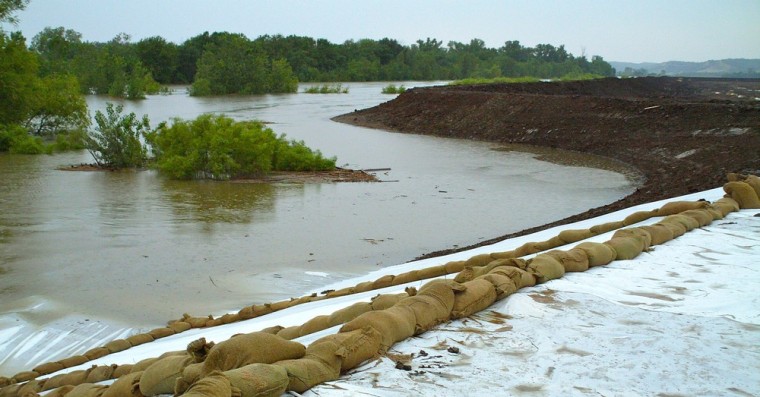The surge of water released from dams holding back the rain-swollen upper Missouri River reached deeper into Nebraska and Iowa on Thursday, headed swiftly toward Missouri and a soggy summer.
Almost all the levees along the way have held strong. There have been no significant injuries or deaths. Now comes the weeks of fretting and worry over whether levees in several states will continue to hold until the river starts to drop sometime this fall.
"The ongoing threat will be to the levees, which were designed to hold back water for a short period of time," said Derek Hill, administrator of Iowa's Homeland Security agency. "We don't know how they will perform if the water level remains high for several months."
Water from one levee breach, five miles south of the small town of Hamburg, Iowa, reached the partially evacuated community late Wednesday. There were no immediate problems with Hamburg's new 8-foot-tall backup levee, which officials scrambled to build during the past two weeks and where about 5 feet of water is eventually expected collect by Friday.
Upriver in South Sioux City, Neb., officials scrambled earlier this month to build a 7,000-foot-long levee to protect the city's northwest side. City Administrator Lance Hedquist said that levee is holding, and the floodwater hasn't even reached it yet in some places.
"Everything looks very good," Hedquist said. "Both levees are strong, healthy. I think our community is safe and well protected."
About six miles away in Dakota Dunes, S.D., a levee partially collapsed Thursday. The damaged section of the south levee was repaired and steps are being taken to prevent further erosion. But Gov. Dennis Daugaard said the partial collapse shows the potential for levee failure is a real danger.
Flooding along the Missouri River has already caused significant damage in Montana, North Dakota and South Dakota over the past month, but no significant injuries or deaths.
The river has been rising for weeks as the corps releases increasing amounts of water from its upstream dams to make room in reservoirs for heavy spring rain and late snowmelt. Releases at Gavins Point Dam in South Dakota hit the maximum planned amount of 150,000 cubic feet of water per second Tuesday, and the corps doesn't plan to reduce the amount it's releasing from its dams until August at the earliest.
National Weather Service hydrologist Dave Pearson said the river levels are expected to remain high, and any significant rainfall could push the river higher.
"Any rain we get below Gavins Point is unregulated and flows right into the river," Pearson said.
That's why officials still predict the river downstream of the six dams could still swell to levels 5 to 7 feet above flood stage at most places in Nebraska and Iowa, and rise as much as 10 feet above flood stage at some places in Missouri.
In Nebraska and Iowa, the river remained about 1 foot below those levels on Thursday.
Col. Bob Ruch, the U.S. Army Corps of Engineers district commander in Omaha, said there are no plans to deliberately breach a levee along the Missouri as the Corps did during flooding earlier this year along the Mississippi River.
Among the reasons, he said, is there is no place behind Missouri River levees for the water to go.
"Omaha and Council Bluffs, you can literally see water from bluff to bluff," Ruch said. "The space is just not available and there is no plan to do so."
In Omaha, officials announced Thursday an evacuation plan for the unlikely possibility of widespread flooding in Nebraska's biggest city. Officials said roughly 2,700 Omaha residents would have to evacuate in that worse-case scenario.
Assistant Omaha fire chief Dan Stolinski said such an evacuation order would only be issued in the event of massive levee breach.
